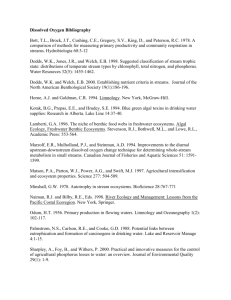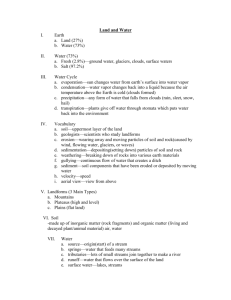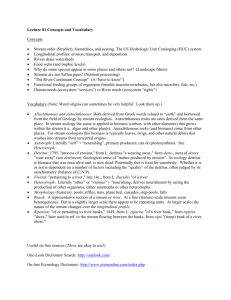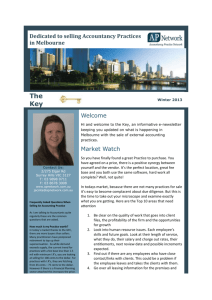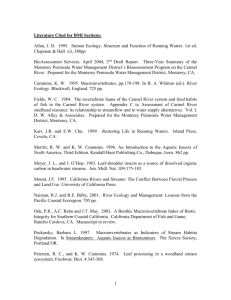Business Models for Internet based E-Commerce
advertisement
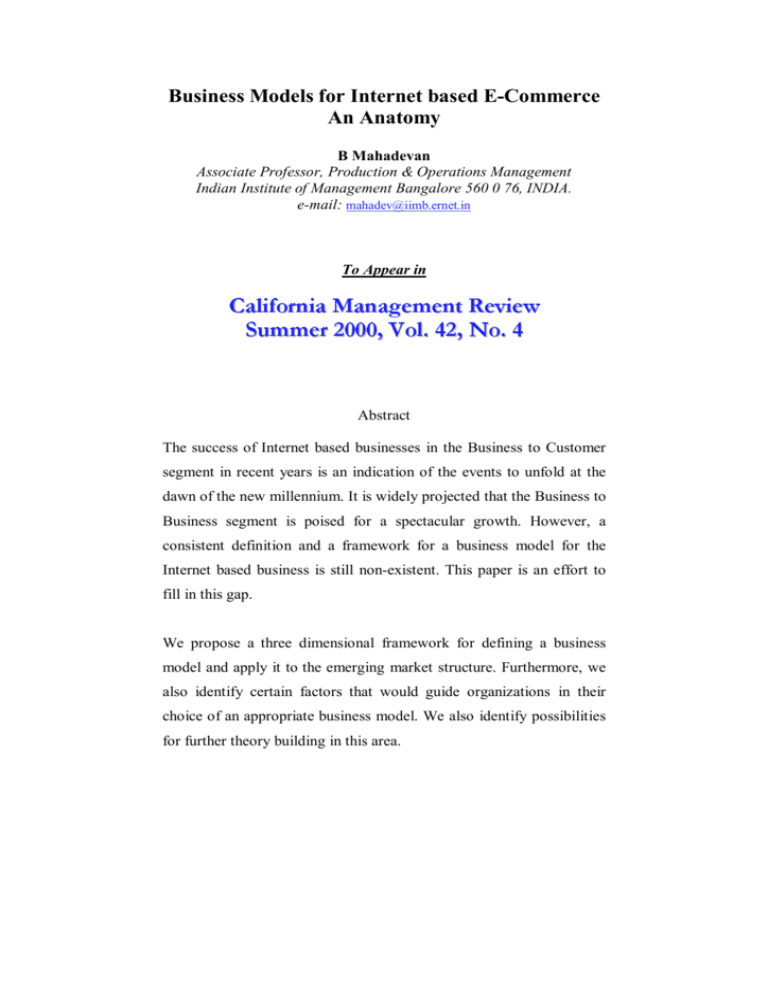
Business Models for Internet based E-Commerce An Anatomy B Mahadevan Associate Professor, Production & Operations Management Indian Institute of Management Bangalore 560 0 76, INDIA. e-mail: mahadev@iimb.ernet.in To Appear in &DOLIRUQLD0DQDJHPHQW5HYLHZ 6XPPHU9RO1R Abstract The success of Internet based businesses in the Business to Customer segment in recent years is an indication of the events to unfold at the dawn of the new millennium. It is widely projected that the Business to Business segment is poised for a spectacular growth. However, a consistent definition and a framework for a business model for the Internet based business is still non-existent. This paper is an effort to fill in this gap. We propose a three dimensional framework for defining a business model and apply it to the emerging market structure. Furthermore, we also identify certain factors that would guide organizations in their choice of an appropriate business model. We also identify possibilities for further theory building in this area. Business Models for Internet based E-Commerce: An Anatomy Introduction The growth of Internet based businesses, popularly known as dot coms is anything but meteoric. It has dwarfed the historical growth patterns of other sectors of the industry. Over years, several organizations doing business through the Internet have come out with their own set of unique propositions to succeed in the business. For instance Amazon.com demonstrated how it is possible to "dis-intermediate" the supply chain and create new value out of it. Companies such as Hotmail, and Netscape made business sense out of providing free products and services. On the other hand companies such as AOL and Yahoo identified new revenue streams for their businesses. It is increasingly becoming clearer that the propositions that these organizations employed in their business could collectively form the building blocks of a business model for an Internet based business1. Several variations of these early initiatives as well as some new ones being innovated by recent Internet ventures have underscored the need for some theory building in this area. A good theory is a statement of relations among concepts with in a set of assumptions and constraints. The purpose of theory is two fold2: to organize (parsimoniously) and to communicate (clearly). Wallace3 outlined a systematic approach to theory building, which broadly consists of observation, induction and deduction. Theory building in a new area often begins with individual observations that are highly specific and essentially unique items of information. By careful measurement, sample summarization and parameter estimation, it is possible to synthesize empirical generalizations. The next stage in theory building involves concept formation, proposition formation and proposition arrangement. Using sampling the hypothesis 1 that occasioned the construction of the proposition could be tested. Eventually, the results of hypothesis testing enables confirmation, modification or rejection of the theory. In this paper we focus on observation and induction aspects of theory building. Another key aspect of theory building is the use of alternative classification schemes often employing typologies and taxonomies4. Typological classification has a twofold function: codification and prediction. A typology creates order out of the potential chaos of discrete and heterogeneous observations. But in so codifying the phenomena, it also permits the observer to seek and predict relationship between phenomena that do not seem to be connected in any obvious way. This is because a good typology is not a collection of undifferentiated entities but is composed of a cluster of traits, which in reality hang together. Indeed systematic classification and the explication of rationale for classification are tantamount to the codification of the existing state of knowledge in a discipline5. This paper is an effort on the theory building process that incorporates several of the above features such as observation, induction and classification. We particularly identify and focus on two broad issues concerning organization engaging in Internet based business: Is there a basis on which one can classify these new propositions? and are there any factors that could potentially influence an organization in identifying an appropriate sub-set of these propositions for its business? We propose to address these issues in this paper. Barua et al.6 proposed a four-layer framework for measuring the size of the Internet economy as a whole. The Internet infrastructure layer addresses the issue of backbone infrastructure required for conducting business via the net. Expectedly, it is 2 largely made up of telecommunication companies and other hardware manufacturers such as computer and networking equipment. The Internet applications layer provides support systems for the Internet economy through a variety of software applications that enable organizations to commercially exploit the backbone infrastructure. Over years, several applications addressing a range of issues from web page design to providing security and trust in conducting various business transactions over the net have been developed. The Internet intermediary layer includes a host of companies that participate in the market making process in several ways. Finally, the Internet commerce layer covers companies that conduct business in an over all ambience provided by the other three layers. We refer to their paper for more details on the four layers and the type of organizations included in the four layers. The Internet infrastructure layer and the applications layer play a crucial role in moderating and trend setting the growth of Internet economy. However, in this paper, we draw our attention to the notion of a business model as applicable to the last two layers. The focus on the last two layers stems from several reasons: (a) The growth of the intermediary and the commerce layer is significantly higher than that of the other two layers. Barua and Whinston7 reported a 127% growth in the commerce layer during the first quarter of 1999 over the corresponding period in 1998. Furthermore, one in three of 3400 companies that they studied did not even exist before 1996. They also reported that 2000 new secure sites are added to the web every month indicating the creation of new companies and migration of existing brick and mortar businesses. 3 (b) The extensive customer interaction in these two layers has offered more scope for creating unconventional business models and hence offers more scope for identifying certain typologies Moreover there has been no attempt to provide a consistent definition for a business model in the Internet context. On the other hand, consultants and practitioners have often resorted to using the term business model to describe a unique aspect of a particular Internet business venture. This has resulted in considerable confusion. Before we elaborate on the theme, we clarify the scope of the term "Internet based Ecommerce". Our definition of this term does not include organizations that have merely set up some web sites displaying information on the products that they sell in the physical world. On the other hand, only those organizations that conduct commercial transactions with their business partners and buyers over the net (either exclusively or in addition to their brick and mortar operations) are considered. Henceforth, our reference to the term "Internet Economy" is limited by the scope as we have identified here. Our purpose extends beyond providing a formal definition and an anatomy to the business model. We use the proposed framework to relate to the market structure in the Internet economy. We begin with a broad classification of emerging market structures in Internet based business. We provide a definition for a business model and elaborate on the idea by identifying its various facets in the context of Internet. Finally, we identify certain dimensions that could potentially influence organizations in their choice of an appropriate business model out of the building blocks that we have identified. 4 The emerging market structure The Internet economy has divided the overall market space into three broad structures: Portals, Market Makers, and Product/Service providers. A portal (POR) engages primarily in building a community of consumers of information about products and services. Increasingly, portals emerge as the focal points for influencing the channel traffic into web sites managed by Product/Service providers and other intermediaries. They primarily play the role of funneling customer attention or "eyeballs" into these web sites in a targeted fashion. Companies such as AOL and Yahoo largely cater to the Business to Customer (B2C) segment. However, it is not uncommon to find portals in the Business to Business (B2B) segment also8. Ariba.com and MarketSite.net (promoted by Commerce One) are portals serving B2B segment. Market Maker9 (MMK) is another emerging structure in the Internet market space. A market maker plays a similar role of a portal in building a community of customers and/or a community of suppliers of products and services. However, it differs from portals in several ways. Firstly, market makers invariably participate in a variety of ways to facilitate the business transaction that takes place between the buyer and the supplier. Consequently, often a market maker is expected to have a high degree of domain knowledge. For instance, a portal such as Yahoo can funnel the traffic of prospective computer and software buyers into web sites that provide services related to selling these. However, a market maker such as Beyond.com require a higher domain knowledge related to buying and selling of computer and software products to add value to the business. Lastly, unlike a portal, a market maker endeavors to provide value to suppliers and customers through a system of implicit or explicit 5 guarantee of security and trust in the business transaction. Auction sites such as e-bay are the early market makers in the B2C segment. On the other hand a large number of market makers are evolving in the B2B segment. Some examples include Chemdex (Chemicals), HoustonStreet.com (Electricity), FastParts (Electronic components), BizBuyer.com (small business products) and Arbinet (Telecommunication minutes and bandwidth). B2B segment has several characteristics that promote a bigger role for market makers. These include huge financial transactions, greater scope for reducing product search costs and transaction costs. Since B2B e-commerce application is poised for a spectacular growth, the role of market makers will be increasingly felt. There will be wide scope for catering to either a vertical or a horizontal market hub. The predominant forms the market makers take in B2B segment include organizing auctions and reverse auctions, setting up exchanges and product and service catalogue aggregation. The third market structure will comprise the product/service providers (PSP) dealing directly with their customers when it ultimately comes to the business transaction. The suppliers will conduct their business with their partners directly over the net. This will call for extensive customization of their information system and business processes to accommodate customer requirements on line. Notable examples in this category of market structure include companies such as Amazon.com and Landsend.com in the B2C segment and companies such as Cisco and Dell Computers in the B2Bsegment. The emerging market structure indicates a few characteristics of the Internet based ecommerce business applications. Firstly, each of these addresses a key constituent of 6 the business that is carried out over the net. Secondly, the three market structures exist in both B2B and B2C segment. Thus they cover the whole gamut of the Internet economy. Table 1 is a representative list of companies in the emerging market structure in B2C and B2B segments. Furthermore, there is a high level of overlap and inter-dependency among the players in the three market structures. For instance players in the PSP market will succeed in marketing their products and services only when they catch the attention of prospective customers outside their web site. In order to do this they may often need the support of a POR. As we know, the revenue stream of a POR or a MMK depends to a large extent on its relationship with PSP. Finally, since the fundamental purpose of the three market structures are very different, one would expect different approaches to the value that they offer to their business partners and customers and the manner in which they organize their revenue stream. Figure 1 illustrates the relative emphasis the players in these market structures place on three dimensions. Portals lay more emphasis on building a community of customers and channeling the customer eyeball traffic. On the other hand, market makers are more interested in building a community of both suppliers and buyers. Organizations in the PSP market structure will however, focus more on building a community of buyers. The other two dimensions are of less importance to this group. It will therefore be interesting to understand how existing organizations in these segments have carved out business models. We turn our attention to this aspect by developing a notion of a business model. Business Models for Internet based e-commerce Understandably, for the sector of the industry that is hardly a decade old, a formal definition of a business model is non-existent. There have been scanty attempts in the 7 past to formally define and classify business models in the Internet context. In our understanding these attempts are neither complete nor robust. However, we present a brief over view of these for the sake of completeness. Schlachter10 identified five possible revenue streams for a web site. These included subscriptions, shopping mall operations, advertising, computer services and ancillary business. The emphasis was to show how revenue models existing in the brick and mortar scenario would be exploited in a web based business. Fedwa11 identified seven revenue generating business models. In addition to the revenue streams identified by Schlachter, Fedwa added timed usage and sponsorship and public support as possible revenue streams. Based on a qualitative analysis of the Internet based models pertaining to grocery and delivery of customer packages Parkinson12 stressed the role of business affinities such as logistic providers in creating the value proposition. These models were too narrow in their scope and do not cover the gamut of alternatives employed by today's Internet-based businesses. Perhaps a better description of the business model was provided by Timmers13. Timmers identified eleven business models that currently exist and classified them on the basis of degree of innovation and functional integration required. Figure 2 shows the classification scheme and some representative examples. These business models describe a particular unique aspect of doing business over the net and ignore other aspects. A good theory should ensure that the factors considered as part of the explanation of the phenomena of interest should possess comprehensiveness and parsimony14. Previous attempts to define business models for Internet based business do not satisfy these requirements. For instance, the example of Amazon.com for building a virtual 8 community (see figure 2) does not bring out another unique feature, viz., disintermediation of supply chain. We argue that a business model is a unique blend of three streams that are critical to the business. These include the value stream for the business partners and the buyers, the revenue stream and the logistical stream. Value stream identifies the value proposition for the buyers, sellers and the market makers and portals in an Internet context. The revenue stream is a plan for assuring revenue generation for the business and the logistical stream addresses various issues related to the design of the supply chain for the business. The long-term viability of a business largely stems from the robustness of the value stream. Furthermore, the value stream in turn influences the revenue stream and choices with respect to the logistical stream. Value streams in Internet based business Figure 3 is an illustration of value streams in Internet based business. Often, buyers perceive value arising out of reduced product search cost and transaction costs. Further the inherent benefits of the richness and reach of the Internet provides an improvised shopping experience and convenience. It is not uncommon for the buyers to have benefits that spill over to other domains. For example, a market maker offering air line tickets may provide, in addition, hotel and car rental services for the buyer when he purchases a ticket to her holiday destination. Furthermore the buyer will also have access to the views of a community of people who visited the same place previously at the same time of the year. The value these online communities provide to buyers is hard to replicate in the physical world. 9 Suppliers often perceive value arising out of reduction in customer search costs, cost of product promotion, business transaction costs and lead time for business transactions. These benefits are likely to be substantial in the B2B segment. For instance, Siebel and House15 reported that car dealers spend on an average about $ 25 to close business with a buyer referred by autobytel.com as opposed to several hundreds of dollars in the brick and mortar operation. There is virtually zero customer search costs in such referrals. The introduction of a market maker or a portal is likely to increase the value for both the buyers and the customers in addition to its own. This sets in a virtuous cycle for all the three players. As more suppliers join in the market making process, the buyers begin to see more choices for them. As more buyers join, the suppliers will begin to experience the beneficial effects of a wide customer base and lower customer search costs. The buyers themselves will benefit from the growing community of buyers. Finally, both the buyers and the suppliers begin to rely on the market maker/portal. This ensures a robust revenue stream for the market maker/portal. The above example shows that there is potential for identifying alternative value streams based on the market structure in which the Internet based business is set up. We identify four possible value streams in an Internet based business: Virtual Communities (V1) Virtual communities offer a multitude of values to the buyers, sellers and the market makers and portals. Communities have a distinctive focus that brings together people with common interests. Ethnicgrocer.com is a business venture that caters to the grocery requirements of Asians and Hispanics. However, the community building 10 effort extends beyond just providing groceries. Hagel16 observed that it is extremely difficult to replicate the value proposition of virtual communities because much of the value of these communities is member generated. Moreover, communities induce a high switching cost for the members of the community and thereby provide first mover advantage for the organizations that host these communities. Dramatic reduction in transaction costs (V2) An electronic market place is an inter-organizational information system that allows a buyer or a seller, an independent third party or a multi-firm consortium to exchange information about prices and product offerings. Moreover the costs of product and price comparisons become negligible. A major impact is that they typically reduce search costs for both the buyers and the sellers. Bakos17 argued that as search costs come down, the prices come down both in a commodity and in a differentiated market. Furthermore, as more and more participate in this process, the benefits increase due to what is known as network externalities in economics18. This reduction in costs could form a value proposition in terms of increased margin or lowering of product prices. The recent experiences of dot coms in the B2C segment have adequately demonstrated this phenomenon. However, the benefits of this value proposition are inversely proportional to the number players conducting business online. As more and more competitors switch to electronic markets, this will cease to differentiate between them. Gainful exploitation of information asymmetry (V3) The effects of asymmetric information on market equilibrium have been studied in a multitude of economic situations and models proposed to address these issues. The 11 models can be differentiated as search models19 and bargaining models20. These models provide the basis for a role for intermediaries who seek to bring the price quality combinations close to informationally efficient combinations. Coupled with the effect of network externalities, the ubiquitous nature of Internet business operations have opened up new value streams that can exploit information asymmetry existing in several business transactions. In situations that involve numerous buyers of products and services spread over large geographical area and sellers who have perishable products and services it is possible to exploit the benefits of information economy into a value proposition. In travel, hotel and tourism industry there are a variety of product offerings and high levels of uncertainty of patronage. Since the services are perishable in nature, it is possible to buy out these left over services at a competitive price and re-sell it at a higher value. The sellers do not have perfect information on demand. Similarly, the buyers do not have perfect information on the supply. Therefore an intermediary can create value arising out of this information asymmetry. Priceline.com is an illustrative example for such a value stream in a B2C segment. Even in the case of non-perishable items, it is possible to exploit the information asymmetry by the setting up online bids and reverse auctions. In the B2B segment, information asymmetry often exists when there are several potential suppliers for an industrial bid. By enabling an online real time bidding and negotiation process it is possible to obtain substantial reductions in the final bid value. An intermediary who enables this process usually creates a value proposition and a revenue stream that is linked to the value of the reduction obtained for the buyer. Free Markets Online Inc., a Pittsburgh based intermediary is an example of this category21. 12 Free Markets assists industrial buyers in posting requests for proposal (RFPs) and holding Internet based reverse auctions for their products. By automating the flow of information, a large number of suppliers can be effectively included in the RFP process, resulting in more competition and lower costs for the buyer. Value added market making process (V4) Our previous discussions on value streams in the Internet context are sometimes augmented by some additional value propositions. These could be the main value generating streams in some cases. Security and Trust, for instance, are major concerns in Internet based e-commerce. Hence, it is possible to invent a value proposition with this theme. When the market maker vouchsafes the transactions that take place under its domain it is a significant value to buyers and sellers. The seafood industry often brings small buyers and sellers together who don't know each other. By providing its trusted third party credit rating information, Seafax imparts to buyers and sellers the confidence to trade with unknown trading partners, thereby improving the market liquidity. A similar role in the B2C segment is played by ebay. Providing financial instruments and establishing credible guarantee for the transactions are potential application domains. In a similar fashion addressing privacy and delivery reliability concerns will also have the potential for identifying new value streams. The quantum of transactions and the financial value are quite high in B2B segment. Moreover, the process of selling often involves a few third party service providers such as logistics. Such applications offer more scope for creating these value streams in B2B segment. The potential value propositions offered could include a combination of several of the following: • Credit verification 13 • Buying guides • Risk management • Procurement management • Quality Assurance • Order fulfillment • Credit verification • Security & Trust • Financial Instruments (Cyber Cash) • Escrow The value streams identified above are not mutually exclusive. For instance, organizations creating a value stream on the basis of online communities will also be able to exploit the benefits of reduced transaction costs or some additional value through providing enhanced security. However, we argue that organizations often build their model on the basis of one dominant value stream. The value derived from others is incidental and supplementary to the main value stream. Revenue Streams in Internet based Business Value stream addresses the long-term sustainability of the business proposition and often sets the context for identifying revenue streams for an organization. The revenue steam is nothing but the realization of the value proposition in a short-term, usually on a yearly basis. In addition to the traditional modes of revenue generation, the Internet economy has allowed organizations to exploit new revenue streams that are hard to replicate in a brick and mortar operation. We discuss here six such revenue streams. Increased margins over brick & mortar operation (R1) Internet based businesses will invariably have increased margins on account of several factors. As we have already pointed out, the prominent among them include 14 reduction in transaction costs and customer search costs. Furthermore, cost reduction could also be achieved through dis-intermediation of the supply chain. The classic example of Amazon.com offering as much as 50% discount on New York Times best sellers and 30% discount on other titles is a result of dis-intermediation of the supply chain. The increase in margins on account of these could be further compounded by an increase in sales turnover. The cost reduction attained in this fashion is likely to be partly off set by the additional costs incurred in hosting banner ads on other sites in order to funnel customer attention into one's own web site. However, it appears that the net effect of these is an increase in margins. Revenue from online seller communities (R2) By providing free membership22 market makers build a community of buyers and get access to a host of information of their interest. It builds certain features that help buyers perceive value in associating with the market maker. For instance, compare.com provides a potential buyer of entertainment electronics such as camcorders with all information on price, products and allows for a variety of comparisons. Over a period of time, the market maker could induce high switching costs for the buyers. Similarly by promising an untapped source of buying community, they build a community of suppliers. The suppliers experience a reduction in customer search costs by entering into such markets. Once the community of suppliers and buyers are in place, the market maker can build a revenue stream out of charging the suppliers a one time membership fee and a variable transaction fee linked to the quantum of 15 business performed through the market maker. There are several examples of these in both the B2C and B2B. Advertising (R3) The ubiquitous nature of the Internet operations and the ability of certain organizations to build a community of buyers have allowed these organizations to look towards advertising as the main source of revenues. Portals (including the search engines) and large community sites such as Yahoo, AOL, MSN and Hotmail play a crucial role in funneling the customer eyeballs into the target web sites. It is natural for these web sites to host banner ads and generate huge revenue to support their operations. Variable pricing strategies (R4) Organizations that are in the business of selling electronically delivered products23 have unique characteristics of the information economy to exploit. High initial cost and nearly zero marginal cost often characterize information production and dissemination. Hence a pricing scheme based on marginal costs is not applicable for this class of products. However it is possible to use a range of alternatives involving variable pricing and bundle and option pricing. Different consumers have different valuations for one particular piece of information indicating a different willingness to pay. Varian24 argued that if the willingness to pay is correlated to some observable characteristics of the consumers such as demographic profile, then it could be linked to the pricing strategy. Student and University versions of software are examples of this category. Another strategy could be bundling of goods to sell to a market with heterogeneous willingness to pay25. 16 Revenue streams linked to exploiting information asymmetry (R5) As we have already pointed out, an intermediary exploiting the information asymmetry between the buyer and the supplier generates a revenue stream often linked to the quantum of savings accruing to the buyer. Several variations of the auction formats are being used. Free offerings (R6) The notion of providing free products and services is not a recent phenomenon. During world war, Gillette was reported to have supplied US marines with shaving razors with replaceable blades. Every user of such a razor could potentially expand the market for blades later. The fundamental philosophy behind free services has been one of giving away today's revenues in return for assured future revenues. The case of Adobe Systems in giving away Acrobat readers free exploits a similar idea. As more and more users read documents with Acrobat readers, they feel the urge to create documents using Acrobat. They will eventually end up buying the full version of Acrobat. In both the above cases, the organizations gave away free only part of their product/services. However, organizations such as Hotmail and Netscape identified several other revenue streams arising out of totally giving away free products/services. In an Internet context, the following exciting possibilities open up once an organization adopts this aspect: • Free offerings dramatically catalyses the process of building a community of consumers. When Hotmail provided free e-mail service, it built a huge online 17 community of consumers waiting to be channeled into a multitude of web sites of products and services. • Such a large community attracts the attention of potential sellers of products and services. The community of sellers will be willing to pay for advertising. • If the organization decides to build a community of suppliers, the suppliers will be willing to pay a membership fee and a variable transaction fee. • Sometimes, the free option results in global spread of customers and results in free customer feedback and product improvement initiatives. The success of Netscape browser and the Linux operating system is attributed to this phenomenon. We believe that although the notion of free offerings as a revenue stream sounds paradoxical it is by far radical. Moreover, it has numerous spin-offs leading to other revenue streams as we have demonstrated (figure 4). We would expect this to occupy a central role in providing a formidable revenue stream as it has the first mover advantage. Logistic streams for Internet based Business The Internet economy allows an organization to position itself at an appropriate level of the supply chain depending on the nature of its business. Three distinctive logistical streams exist in the Internet economy and all the three streams have evolved out of the need for creating the maximum value for the customers. Dis-intermediation is the process by which the logistical stream is shortened leading to better responsiveness and lower costs. On the other hand, Internet based business also calls for new forms of intermediation. Infomediaries and meta-mediaries seek to add value to the 18 logistical stream by addressing certain problems arising out of information overload and transaction cost inefficiencies. Dis-intermediation (L1) Due to the nature of certain products and services offered, Internet has made it possible to shrink the supply chain by a process of dis-intermediation. Consequently, transaction costs have reduced and responsiveness to customer requirements has improved considerably. These improvements often lead to price reduction and or increased margin and sales turnover. The success of Amazon.com over Barnes & Nobles and that of Encarta over Encyclopedia Brittanica have adequately demonstrated the benefits of this logistical stream. In the B2B segment, the success of Dell Computers and that of Cisco are largely attributed to this phenomenon. The success of companies selling information data bases consisting of a large number of journals in electronic form in bringing down the cost of maintaining libraries is also related to this phenomenon. Infomediation (L2) In the market for information the number of sources and suppliers of information as well as the amount of information is much higher than a single information seeker can handle. This is primarily due to a spectacular growth of Internet sites. Individual information seekers can not contact every possible source of information, nor can they estimate the accuracy and true value of the information offered. This has necessitated a crucial role for an intermediary to address information requirements of the users. This often involves storage and dissemination of meta-information, for example, references to information concerning a particular topic. Examples of information 19 intermediaries offering this meta-information as a service in Internet based business are primarily portals comprising of search engines and electronic product catalogue aggregators. Hagel and Rayport26 argued that infomediaries in the future would act as custodians, agents and brokers of customer information and market it to businesses on customers' behalf while protecting their privacy at the same time. Meta-mediation (L3) Metamediation is a process that goes beyond aggregating vendors and products and includes additional services required for facilitating transactions. Certain markets (in the B2B segment) are characterized by fragmented supply chain leading to high vendor search costs, high information search costs, high product comparison costs, large market size and huge work flow costs. Under these conditions, meta-mediation will add value to the buyers, sellers and the intermediary. It may be noted that our classification of the emerging market structure closely follows that of the above logistical streams. The Portals utilize the infomediation stream and the market makers utilize the meta-mediation stream. Some players in PSP will be able to exploit the dis-intermediation stream for their business model. Towards an appropriate business model The alternatives that we have presented under each stream merely indicate the possible options available to an organization. However, the process of arriving at an appropriate business model involves picking up the right mix of alternatives. A few 20 aspects that are peculiar to its business often guide an organization. In particular the following factors have a bearing on the choice of the business model: Assumed role in the market structure Organizations will be able to narrow down their choices by an understanding of the role that they play in the Internet economy. Table 2 illustrates the alternative available for organizations in each market structure. For instance, the logistical stream sharply divides the three market structures. Similarly, while a market maker will be able to utilize all the four value streams, streams such as reducing transaction costs and exploiting information asymmetry are not of much use to a portal. The information presented in the table is a useful beginning to the process of arriving at an appropriate business model. However, it is abstract and can at best offer some broad guidelines. Within each market structure there are significant variations in the nature of the activities that organizations perform. For instance, the PSP segment includes organizations such as Amazon.com, which sells books and music and furniture manufacturers such as Ethen Allen. Can Ethen Allen replicate the disintermediation model of Amazon and hope to achieve the same degree of success? Perhaps the answer is no. There are significant aspects that ultimately influence an organization towards its choice of an appropriate business model. This leads us to other factors. Physical attributes of the goods traded Goods traded over the net could be either informational goods (soft goods, that could be transported electronically) or physical goods (hard goods that need physical transportation by a logistics provider). This differentiation influences the choice of an 21 appropriate revenue stream. For instance, variable pricing strategies, free offerings, and a combination of a one time fee and a variable transaction based fee are potential options for organizations trading soft goods. Organizations trading hard goods will often have to resort to unique options that provides increased margins and/or premium over the brick and mortar operations. In the case of other organizations engaged in providing a variety of services for Internet based businesses it is possible to employ a combination of the proposed revenue streams. The choices with respect to logistical streams are obvious for an organization trading soft goods. Such organizations will eventually gravitate towards dis-intermediation. However, in the case of hard goods there are other factors that govern an appropriate choice of the logistical stream. Personal involvement required in buying - selling process The choice of the logistical stream for hard goods is significantly affected by this factor. Goods traded over the net broadly fall into two categories: experience goods and economy goods. Experience goods require greater personal involvement in the buying process. This could be in the form of making an assessment of the suitability of the buy by physically handling and examining the good to be purchased. Attributes such as color, texture and the experience of using it on a test basis are crucial determinants of the buying decision. Dis-intermediation of the supply chain is a risky strategy for such goods. On the other hand, the use of infomediaries and metamediaries will greatly enhance the value by facilitating the process. Moreover they can also play a significant role in reducing search costs and transaction cost inefficiencies. 22 A case in point is the role played by Autobytel.com, a portal that assists potential buyers of automobiles. A potential buyer uses Autobytel in three ways. Initially, the buyer understands the options available for her and the comparative aspects of one manufacturer/model over the other. This drastically reduces the product search costs for the buyer. In the second stage, the nearest dealer who is an affiliate of Autobytel contacts the buyer. The dealer helps the buyer in discovering her experience of using a vehicle. Once the buyer makes up her mind, she returns to Autobytel for price and loan negotiations. The customer search costs are drastically reduced for the dealer and the buyer gets better price as a result of this process. On the other hand, economy goods are ideal candidates for dis-intermediation. The driving force in this case is to reduce the costs by eliminating portions of the value chain that do not seem to add any value. Many goods traded in the B2B segment will fall in this category. Conclusions The unprecedented growth in Internet based business in a short period of time has underscored the need for understanding the mechanisms and theorizing the business models adopted by successful organizations. We have begun this process by providing a framework to understand how business models are designed for organizations comprising the Internet economy. The process has one been of making certain empirical generalizations. However, it allows for theory building in several ways. For instance, it is possible to develop several propositions and constructs using this framework for further empirical testing. These could relate to the market structure, the three streams or the specifics of the business as applicable to this framework. 23 Specifically, we envisage more efforts in empirically verifying our framework and the variables constituting the business model. We propose that a deeper understanding of the relationship between the market structure and the choice of the business model be investigated by specific case studies. Furthermore, it will be a useful addition to the theory if we could establish the variables that drive organizations to specific choices in the three streams over the other. 24 Table 1 A sample list of Internet based Businesses in the emerging market structure. Market Structure Portals (POR) Market Makers (MMK) Product/Service Providers (PSP)$ B2C Segment AOL.com Askjeeves.com Compare.com MSN.com Personalogic.com Yahoo.com Orlando.com Autobytel.com Beyond.com Buy.com Cameraworld.com Careerbuilder.com Ebags.com Ebay.com Etrade.com NetMarket.com Priceline.com Travelocity.com Ubid.com Amazon.com Egghead.com EthnicGrocer.com Landsend.com Stacianewyork.com B2B Segment* Cnet.com ec-portal.com MarketSite.net Netmarketmaker.com Questlink SmartOnline.com VerticalNet @griculture Online AdAuction.com AsianSources.com Bloomberg ChemConnect Manheim Auctions MRO.com NetBuy.com PaperExchange.com PlasticsNet.com Ultraprise Works.com Cisco Compaq Dell * Many portals in the B2B segment have evolved into market maker structure. $ Several existing brick and mortar retailers such as Wal-Mart and manufacturers such as Barnes & Nobles and Sears also engage in Internet based businesses with newly incorporated dot coms. Similar examples exist in B2B segment also. 25 Table 2 Potential applications of business model streams for the three market structures Business Model Building Blocks Market Structures Portals (POR) Market Makers (MMK) Product/Service providers (DDC) ✔ ✔ ✔ V2 ✔ ✔ V3 ✔ Value Streams V1 V4 ✔ ✔ Revenue Streams ✔ R1 R2 ✔ ✔ R3 ✔ ✔ ✔ R4 ✔ R5 R6 ✔ ✔ ✔ Logistical Streams ✔ L1 L2 L3 ✔ ✔ 26 Funneling customer "eyeballs" to web sites POR Building a community of suppliers PSP MMK Building a community of customers Figure 1. The Relative emphasis in the three emerging market structures. 27 Figure 2. A classification of eleven business models (Timmers, 1998). Source: Timmers, P. (1998), "Business Models for Electronic Markets", Electronic Markets, Vol.8, No.2. 28 Buyers perceive added value More options for customers Better price Improved service Greater convenience Improvised experience Numerous other benefits More selling Increased supplier base More reliance on MMK/POR Market Maker/Portal perceives added value More buying A robust revenue stream High switching costs for buyers/sellers More reliance on MMK/POR Suppliers perceive added value Reduced customer search costs Reduced supply chain transaction costs Reduced sales promotion efforts Increased customer base More business for suppliers Figure 3. Value streams in Internet based business. 29 First Mover Advantage Faster feedback, product improvement initiatives Assured revenue generating streams for the future Community of Consumers Free Offering of Product/Service Community of Sellers Additional revenue streams (fixed and variable transaction fee) Advertising Revenue Figure 4. The spin-off effects of Free Offerings as revenue stream 30 Acknowledgements This research is partly supported by the Center for Asia and the Emerging Economies at the Amos Tuck School of Business Adminstration, Dartmouth College, Hanover, NH 03755, USA. 1 In this paper we use alternative terms such as "Internet based business", "Internet based Ecommerce" and "business over the net" in an interchangeable fashion. We do not draw any distinction among these. 2 S.B. Bacharach, "Organizational theories: some criteria for evaluation". The Academy of Management Review. 1989, Vol.14 (4), 496 - 515. 3 W. Wallace, "The Logic of science in sociology", Aldine Autherton, Chicago, IL, 1971. 4 Organizational theory researchers make a finer distinction between a typology and taxonomy. While the former is "theoretical and ideal" the later is empirically grounded. For more discussion on the relative merits of typologies and taxonomies we refer the reader to several articles that have appeared in Vol. 36 (6) of "The Academy of Management Journal". 5 E.A. Tiryakian, "Typologies" in D.L. Sills (Ed.), International encyclopedia of the social sciences. 1968, Mac Millan & Free Press, NY, 177 - 186. 6 A. Barua, J. Pinnell, J. Shutter, and A.B. Whinston, "Measuring Internet economy: An exploratory paper." Working paper, University of Texas, Austin, July 1999. http://cism.bus.utexas.edu/works/articles/internet-economy.pdf. 7 A. Barua, and A.B. Whinston, "Measuring the Internet economy." Cisco Systems University of Texas report. Oct. 1999. The full report is available at http://www.internetindicators.com. 8 Over the years, there is a noticeable trend among Portals to evolve into the Market Maker structure over a period of time by partnering with some third party service providers. Such a trend is particularly significant in the B2B segment. 9 Traditionally a market maker takes possession of goods allowing people to buy and sell goods from it. Because it takes possession of goods, it could also take positions in these goods, thereby profiting from price movements. On the other hand, in our definition, a market maker in an Internet context will not take possession of goods. Instead, it will play the role of match making and facilitate the transaction between the buyer and the seller in many ways. 10 E. Schlachter, "Generating revenues from websites." Board Watch, July 1995. http://boardwatch.internet.com/mag/95/jul/bwm39.html. 11 C.S. Fedewa, "Business models for Internetpreneurs". 1996. http://www.gen.com/iess/articles/art4.html. 12 J. Parkinson, "Retail models in the connected economy: emerging business affinities". 1999. http://www.ey.com/global/gcr.nsf/us/insights_-_eBusiness_-_Ernst_&_Young_LLP. 13 P. Timmers, "Business models for Electronic Markets". Electronic Markets. Vol. 8 (2) 3 8. 1998. 14 D.A. Whetten, "What constitutes a theoretical contribution?" The Academy of Management Review. 1989, Vol. 14 (4), 490 - 495. 15 T.M. Siebel, and P. House, "Cyber rules", Currency Doubleday, New York.1999. 16 John Hagel III, "Net Gain: Expanding markets through virtual communities." Journal of Interactive marketing. 1999, Vol.13 (2), 55 - 65. 17 J.Y. Bakos, "A strategic analysis of electronic market places." MIS Quarterly. 1991, Vol.15 (3), 295 - 310. 18 For details see "M.L. Katz, and C. Shapiro, Network externalities, competition and compatibility. 1985, American Economic Review. Vol. 75(Spring), 70-83." 31 19 20 21 22 23 24 25 26 Y.M. Ioannides, "Market allocation through search: Equilibrium adjustment and price dispersion." Journal of Economic Theory. 1975, Vol. 11, 247 - 262. K. Chatterjee, and L. Samuelson, "Bargaining under incomplete information". Operations Research. 1983, Vol. 31, (5), 835 - 851. A detailed case study on this can be found at " V. Kasturi Rangan, Free Markets Online. 1999. Journal of Interactive Marketing Vol.13 (2), 49 - 65". During the early stages of adopting this aspect of the business model, organizations were charging a membership fee for the customers. However, increasingly organizations have come to realize the importance of providing free membership. By electronically delivered product we mean all those that could be downloaded over the net. These include soft copies of books, electronic journals and research reports, software, music and games. H.R. Varian, "Pricing information goods." Working paper, University of California, Berkeley. In Proceedings of the research libraries group symposium on 'Scholarship in the new information environment', Harvard Law School, May 2 - 3. 1995. See for example "H.R. Varian, Versioning information goods, Working paper, University of California, Berkeley, 1997." John Hagel III, and J.F. Rayport, "The coming battle for customer information." Harvard Business Review. 1997, Jan. - Feb., 53 - 65. 32


